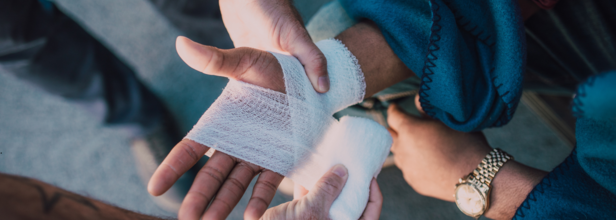
Credits: Canva
How Long Do Wounds Take To Heal?
On our day to day lives, we fall down, or sometimes get a paper cut, or just a kitchen mishap may happen. Then there it is, a wound. It is such a simple, everyday life thing, but have we ever thought about it? How does it heal? The healing process also has stages, mainly four stages, which includes homeostasis, inflammation, proliferation, and remodeling.
So, what are these, and how does it work?
For the uninitiated, skin is body's largest organ and is a barrier to germs, injury, chemicals, and ultraviolet (UV) light. When the skin is injured, it creates a wound and then your body gets at work immediately to start the healing process.
Homeostasis
This is the first stage of the wound healing process. When your skin is injured, the first thing your body does it to create a state of balance and stability by stopping the bleeding. This process is called homeostasis. This is accomplished by tightening the blood vessels, moving platelets to the injury site, as platelet when they aggregate at one place can stop the bleeding. Furthermore, fibrin are formed, which is a form of protein that helps blood clot.
When the fibrin formation is done, a clot develops. This is a very quick process and happens mostly within the first two hours of getting an injury.
Inflammation
This begins once the bleeding is controlled, it starts when inflammatory white blood cells that move towards the wound. These cells clean the wound and also remove the damaged cells and bacteria. This is what creates a scab to cover the injured area.
This stage begins within the very first day of injury and last up to two weeks. It is during this day that you may experience inflammation, swelling, even itching too.
Proliferation
This happens when your skin starts to rebuild it self. This often overlaps with inflammation and during this phase, your body makes new skin tissue and repairs the broken blood vessels that help the new skin tissue to receive nutrients and oxygen.
The skin tissue in this phase is usually a deep red, purple, or even dark brown in color and could have an uneven texture. The process speeds up when the wound is clean and moist.
Remodeling
The last step in the healing process of a wound is remodeling. This is when the wound comes to a close and the cells used for repair are no longer need. So, your body then removes these cells through cellular death also called apoptosis.
This phase starts around three weeks after the injury and could continue for a year or longer, depending on the size of the wound.
How to know if your wound is actually healing?
You can notice the difference in the way your skin changes. When a wound heals correctly, it looks like a healthy wound, the skin gets darker. Whereas, if your wound is not healing, you may see infection, or a discharge. There might be foul odor or prolonged inflammation too.
What may prolong your healing?
There are certain factors which can prolong the healing time, these include:
- Age
- Certain medications
- Diabetes
- Excessive alcohol consumption
- Genetic healing conditions
- Health conditions, especially those affecting your immune status
- Obesity
- Poor nutrition
- Smoking
- Stress
© 2024 Bennett, Coleman & Company Limited

